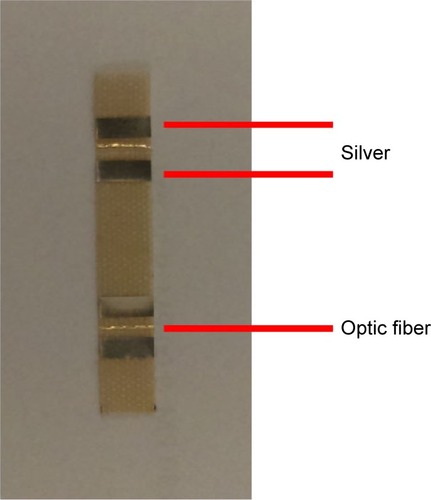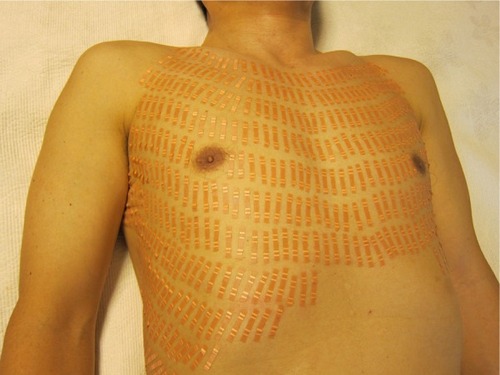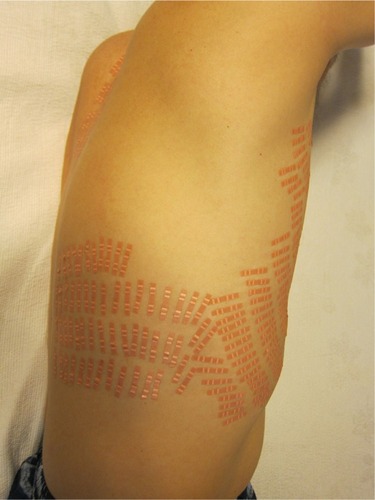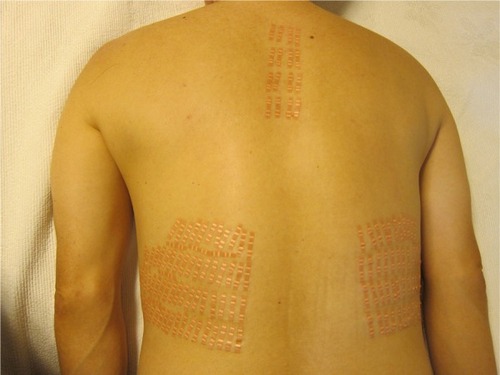Abstract
Introduction
Despite improved research in the treatment, depression remains difficult to treat. Till date, successful treatment of depression using taping therapy has not been known yet. We report cases where patients with severe depressive symptoms were successfully treated by taping therapy, a new approach.
Methods
In case 1, a patient was taking several psychiatric medications for 10 years and admitted often to the psychiatric hospital with a leaning head, flexible legs, and nearly closed eyes; in case 2, a patient after a hysterectomy complained with heart palpitations, depressive- and anxiety-like behaviors, insomnia, and gastrointestinal problems; and in case 3, a patient with complaints of adverse effects from antidepressant medications had suicidal thoughts frequently. The medical tapes were placed on acupoints, trigger points, and pain points found by finger pressing examination in the chest, sides, and upper back of the patients.
Results
In case 1, the patient started weeping immediately after the first treatment. He discontinued psychiatric drugs and returned to baseline functioning after 2 months. In case 2, the patient felt at ease showing decreased palpitation immediately after the first treatment, and after 1 week, she quit medications. In case 3, the patient experienced a sense of calmness following the first treatment and recovered from her symptoms after 2 weeks.
Conclusion
These results suggest the following key points: examination of acupoints and trigger points of chest, sides, and upper back is useful in the assessment of depression; regulating bioelectric currents on these points is helpful in the treatment of depression; and depression can be treated successfully with taping therapy.
Introduction
Depression is a debilitating disease with costly consequences.Citation1,Citation2 Depression has been associated with the poor quality of life, sleep disturbances, and suicidal behaviors.Citation3 Therefore, development of treatments for depression is imperative to decrease individual distress and societal burden as a result of depression. However, despite the widespread availability of antidepressant medications, depression remains difficult to treat.
In an effort to find useful treatments for this disease, practitioners and researchers have sought other strategies beyond conventional treatment approaches.Citation4 One of the ways that practitioners attempt to treat psychiatric diseases, such as depression and insomnia, is by using complementary and alternative medicine.Citation5–Citation7
One of these complementary and alternative medicines that has been gaining interests and may be considered as a useful method in diverse fields is taping therapy. However, taping therapy’s main targets have been focused on muscular dysfunctions typically accompanied by a movement disorder, and till date, there has been a dearth of reports about the usefulness of taping therapy in depression. In our previous study,Citation8 we have suggested that taping therapy regulating bioelectric currents at the acupoints and trigger points (TPs) related to the neurological symptoms is useful for insomnia, and patients with depressive symptoms have been successfully mitigated with taping therapy.
There are some therapies for depression using electronic stimulations, ie, electroconvulsive therapy,Citation9,Citation10 transcranial magnetic stimulation,Citation11,Citation12 and transcranial direct current stimulation.Citation13 However, these electrical therapies are different from our taping therapy in that they use artificial electrical or magnetic stimulations given from outside along with therapists’ setting, while our taping therapy just adjusts the over or down flow of patients’ bioelectric currents without injecting external stimulation.
Based on these practical experiences, we have further examined if taping therapy attenuates chronic depression, and here, we report for the first time that severe depression symptoms can be successfully treated with taping therapy.
Case presentation
Materials
The medical tape used in this study (chimsband; Saeng-Vit Oriental Medicine Clinic, Seoul, Korea)Citation8 has specific materials of silver and optical fiber (). One piece has two functional units, and one unit is composed of two silver lines (length of 4 mm and width of 2 mm) and one optical fiber (length of 4 mm and width of 0.5 mm). These materials were used for their high electrical conductivity.
Methods
Intervention
Method of intervention was attaching tapes to the related sites after finding sensitive or painful response against finger pressure examination.
Evaluation
Effectiveness of this taping therapy was evaluated using the following measures: change in radial pulse and symptoms, termination of taking medications, and the patients’ ratings on the visual analog scale (10: worst and 0: perfect satisfaction).Citation14–Citation16
Ethics information
Ethical approval was not sought for this study, however, this study was performed in compliance with general ethical standard regarding a case study with written informed consents having been provided by the patients.
Results
Case 1
History and examination
A 21-year-old male visited our clinic immediately after discharge from a psychiatric hospital with the status of a leaning head at 45° and a salivating mouth; he seemed to be drug intoxicated. His legs were flexible under holding arms, his eyes were nearly closed as though he felt they hard to lift up, pupils were too bleary to focus, and it was obvious that conversation was impossible. Medical information was obtained from his mother and grandmother as guardians. The patient exhibited gradually worsening sleep and concentration from 7 years of age and was prescribed neurological medications. In middle school, the patient was diagnosed with depression, and symptoms became more severe. Since then, he has been admitted to the psychiatric hospital several times a year. Whenever the patient is leaving the hospital, he showed an increased sedation including this intoxicated-like status. As a routine assessment, we examined the patient’s pulse, and it was strong at 95 bpm.
Treatment and progress
Type C of chimsband was attached to the chest (), both sides (), and upper back () of the patients. Typically, we palpate using finger pressure to elicit a sensitive or painful response. However, in this case, we attached tapes based on our previous studyCitation8 and practical experiences omitting this typical examination, because we could not obtain exact response from the patient. After attachment, the pulse decreased to 82 bpm. Additionally, when we asked what he felt, he became extremely emotional and started to cry. His grandmother stated that she had never seen him cry since diagnosis of depression. We provided instructions to the guardians on how to attach the medical tape on the same points used in our clinic and how to check the patient’s pulse. After 1 week, the grandmother reported that he slept >14 h/d with no special symptoms, and his face became clearer than before the treatment. Although the guardians worried about him having too much sleep, he did not take psychiatric medications. After 1 month from the initial visit, the grandmother reported that the patient had been more engaged with family, more socialized with friends outside, and maintained a stable pulse which averaged at ~76 bpm. After an additional month, she reported that the patient had recovered completely and that no new and needed medications had been taken since our initial treatment.
Case 2
History and examination
A 49-year-old female reported flu-like symptoms after a recent hysterectomy. While experiencing these flu-like symptoms, her surgical site burst following a sneeze resulting in a severe bloody discharge. Thereafter, she was depressed, and heart palpitations occurred. As a result, an antidepressant was prescribed, and additionally, medications for insomnia and indigestion were added. Consequently, the patient began to experience anxiety, increasing heart palpitations (pulse 90 bpm), and exacerbation of insomnia. Upon routine examination at our clinic, the patient complained of a painful response when TPs were palpated at the anterior chest but not on other areas, such as back and sides.
Treatment and progress
After eliciting a painful response to the finger pressure examination, type C of chimsband was attached to the chest (); thereafter, the pulse improved to 82 bpm. After receiving the tapes, the patient stated that she felt at ease immediately and noticed that her heart palpitations had decreased. The next day, the patient reported that she was more alert and that her heart palpitations had disappeared completely (ie, pulse was 72 bpm). She also reported sleeping well throughout the night without sleep medication. We observed that her speech was much slower compared with her initial visit. Over the next 4 days, she self-attached the tape at home. At the next visit, she continued to report symptom improvements: she had quit her medications; her digestion became better; her heart palpitations had disappeared; she was more alert; she experienced less fatigue; and her pulse remained stable (ie, 68 bpm). After 40 days (and only 2 days of continuous tape attachment at home), the patient affirmed the following improvements: all her symptoms had disappeared completely, her heart rate remained on average at 68 bpm, and she has completely recovered to her baseline functioning.
Case 3
History and examination
A 40-year-old female patient presented to our clinic with aggressive behaviors and extreme anxiety. She reported taking several medications prescribed by various doctors. She claimed that the medications were ineffective and with intolerable adverse effects (ie, headache, lethargy, intense anger, and increasing suicidal and homicidal ideations). When she got angry, it was severe enough for her to want to kill her opponent and her heart “filled with anger up to the neck”. She was verbally abusive and had thoughts of suicide countless times because of self-control difficulties. Upon examination, her pulse averaged 90 bpm.
Treatment and progress
Upon palpation response, type C of chimsband was attached to the chest () and upper back (). Thereafter, the pulse decreased to 76 bpm, and patient reported experiencing a sense of calmness. We provided instructions on how to attach the tape at home and recommended her to continue her medications. However, the patient claimed her medications’ ineffectiveness and stated a desire to discontinue. Upon follow-up (3 days after initial visit), her symptoms had improved (eg, she exhibited broad smile). She reported sleeping better, feeling calmer, and less fatigue. Her pulse was 70 bpm. After another week of follow-up, her husband confirmed that the patient had less anger (ie, less in intensity, duration, and frequency: once in the past week). Her pulse was 70 bpm. After another week, she reported significant improvement in her functioning whereby she enjoyed taking care of her children and performed her daily household chores without issues. Her pulse was 70 bpm. After 2 months, her husband reported that the tape had been attached continuously for 1 week and once in a while for about a month. Thereafter, she was not treated with taping for several weeks. According to her husband, although the symptoms reoccur, the reattachment of tapes alleviated her symptoms immediately. Thereafter, no other problems were reported.
Discussion
Typically, depression is associated with various neurological symptoms, and alleviating these symptoms is an effective strategy in the treatment of depression. In this study, patients exhibited the following symptoms: pain response to finger pressure, tachycardia, chest congestion or discomfort, anxiety-like behavior, and fatigue.
In Oriental Medicine, acupoints located on the chest area have been used for psychiatric or neurological manifestations, including chest pain, flank pain, palpitation, chest discomfort, arrhythmia, sighing, insomnia, and depressive behavior.Citation17,Citation18 In addition, upon examination of the acupoints in the chest area, many psychiatric patients endorse sensitive or painful responses against palpation. These are the reasons why we focused on the chest area. Furthermore, our patients showed sensitive or painful responses at the sites around BL15 (back transport point of heart) and BL19 (back transport point of gall bladder) in the back and flank, respectively. Because these sites are related to the functions of heart and gall bladder, respectively, the reported sensitivities may be associated with certain neurological symptoms (eg, tachycardia). Therefore, we chose to attach the tape on these areas.
According to the myofascial pain syndrome theory, neurological symptoms (eg, depressive symptoms, chest discomfort, and cardiac-related symptoms) may manifest with sensitivities on TPs in the chest muscles, including pectoralis major, pectoralis minor, and sternalis. Therefore, focusing on the TPs of the chest muscles is important for treating depression. TP is known to be a solidification point of muscle and usually elicits sensitive or painful responses against finger pressure examination. Furthermore, TP exhibits higher temperatures than normal surrounding and accumulations of lactic acid. These are associated with certain deviant bioelectric currents.Citation19–Citation21 Therefore, normalizing deviant bioelectric currents is required for the treatment of TP. In addition, bioelectricity in a wound, burn, or amputee is known to be related to the reparative power of nature,Citation22 which supports the importance of bioelectricity in the treatment. Consequently, normalizing deviant bioelectric currents on the TPs of chest muscles can be a new strategy for the treatment of depression.
Chimsband used in the this study was developed as a kind of medical tape. It has two essential materials: silver and optical fiber (). Because they have high electric conductivity, these two materials were used to regulate bioelectric currents. When this tape covers the site where the deviant bioelectrical current appears to be exhibited, these materials promote the interchange between the deviant current and the normal current of surrounding; that is, this tape is understood to narrow the gap between the deviant current and the normal current, which restores the normal function at the attached site. This tape can produce such functions because bioelectricity exists on the skin. Most importantly, while physiologically regulating bioelectric current, this therapy is beneficial due to the following features: safe, noninvasive, and introduction of unharmful substances to the body. Based on our experience, the effect of this tape appears immediately, whereby the following responses happen shortly after treatment initiation: calming and relaxing physiological responses and decrease in pulse. Finally, in our previous study,Citation8 attaching this tape at the chest area has been shown to be effective in alleviating chronic insomnia.
Therefore, we investigated the painful response at the chest area, focusing on acupoints and TPs with finger pressure examination. Following treatment, the patients’ severe depressive symptoms have considerably decreased along with the accompanying neurological symptoms. Consequently, patients have to avoid taking needed medications for some of their initial complaints (eg, insomnia). Upon follow-up visits, patients reported satisfactory results from the treatments. In this study, the effectiveness of taping therapy was evaluated by the following measures: termination of taking needed medications, normalization of pulse, alleviation of impairing symptoms (eg, anger, aggressiveness, sedation, suicidality, and homicidality), and improvement in the patients’ ratings on the visual analog scale (from 10 [worst] to 1 or 0 [perfect satisfaction] in all cases) used widely in clinical studies.Citation14–Citation16
An interesting finding was that although certain symptoms reoccurred when the tape was removed, symptoms also improved immediately after reattachment (eg, as shown in the case 3). These events demonstrate that this taping was certainly effective and worth to further study.
It appears that the mechanism of action of this taping may be similar to other stress-related interventions, ie, meditation or relaxation attenuates symptoms by stabilizing the nervous system, decreasing the tension, relaxing the muscles, calming the pulse, and smoothing the diaphragmatic movement.Citation23–Citation25 In this study, treating sensitive or painful response resulted in the downregulation of the pulse, calming of the mind, and slowing of the breathing. These results are similar to the effects of meditation or relaxation.
Conclusion
We confirmed our hypothesis through the presented cases that regulating patient’s bioelectric currents focusing on the acupoints and TPs in areas of chest, sides, and upper back is effective for depressive symptoms. Additionally, assessing with finger pressure to elicit sensitive or painful response is important for examining and treating depressive symptoms, and Chimsband is a useful taping therapy for depression. To better understand how this taping therapy mitigates depression and psychiatric symptoms, further research studies on its exact mechanism are needed.
Acknowledgments
The authors thank Doctor Kwang H Choi and Doctor Lisa Osborn, Uniformed Services University of the Health Sciences, USA, for their valuable discussions about the symptoms of psychiatric and stress-related diseases. This study was supported by the Establishment of the Evidence for Traditional Korean Medicine Clinical Technology On-Demand Project (K16121) of Korea Institute of Oriental Medicine. The views expressed are those of the authors and do not reflect the official policy or position of the Uniformed Services University of the Health Sciences, the Department of Defense, and the United States Government.
Disclosure
All authors are Korean medicine doctors in South Korea (CHH, HSH, YJL, SNL, and BHL) or experts of nursing practice in United States (JJA), who learned meridian, acupoints, and trigger points professionally. There is no commercial relation regarding this article. The authors report no other conflicts of interest in this work.
References
- KimJLeeJProspective study on the reciprocal relationship between intimate partner violence and depression among women in KoreaSoc Sci Med201399424824355469
- KesslerRCBerglundPDemlerOJinRMerikangasKRWaltersEELifetime prevalence and age-of-onset distributions of DSM-IV disorders in the National Comorbidity Survey ReplicationArch Gen Psychiatry200562659360215939837
- McCallWVBlockerJND’AgostinoRJrInsomnia severity is an indicator of suicidal ideation during a depression clinical trialSleep Med201011982282720478741
- DavidsenASFosgerauCFWhat is depression? Psychiatrists’ and GPs’ experiences of diagnosis and the diagnostic processInt J Qual Stud Health Well-being201492486625381757
- KinserPALyonDEA conceptual framework of stress vulnerability, depression, and health outcomes in women: potential uses in research on complementary therapies for depressionBrain Behav20144566567425328843
- WuMCSungHCLeeWLSmithGDThe effects of light therapy on depression and sleep disruption in older adults in a long-term care facilityInt J Nurs Pract201521565365924750268
- EisendrathSJGillungEPDelucchiKLMindfulness-based cognitive therapy (MBCT) versus the health-enhancement program (HEP) for adults with treatment-resistant depression: a randomized control trial study protocolBMC Complement Altern Med2014149524612825
- LeeBHHanCHParkHJLeeYJHwangHSA novel taping therapy for chronic insomnia: a report on two casesComplement Ther Med201321550951124050588
- DybedalGSBjølsethTMBenthJŠTanumLCognitive effects of bifrontal versus right unilateral electroconvulsive therapy in the treatment of majordepression in elderly patients: a randomized, controlled trialJ ECT Epub2016224
- PompiliMDominiciGGiordanoGElectroconvulsive treatment during pregnancy: a systematic reviewExpert Rev Neurother201414121377139025346216
- LefaucheurJPAndré-ObadiaNAntalAEvidence-based guidelines on the therapeutic use of repetitive transcranial magnetic stimulation (rTMS)Clin Neurophysiol2014125112150220625034472
- GeorgeMSPostRMDaily left prefrontal repetitive transcranial magnetic stimulation for acute treatment of medication-resistant depressionAm J Psychiatry2011168435636421474597
- BautovichALooCKatzIMartinDHarveySTranscranial direct current stimulation as a treatment for depression in the hemodialysis settingPsychosomatics Epub2015112710.1016/j.psym.2015.11.006
- KaragülleMKardeşSDişçiRGürdalHKaragülleMZSpa therapy for elderly: a retrospective study of 239 older patients with osteoarthritisInt J Biometeorol Epub2016126
- KomenMMBreedWPSmorenburgCHResults of 20-versus 45-min post-infusion scalp cooling time in the prevention of docetaxel-induced alopeciaSupport Care Cancer20162462735274126805558
- ZhangHSunJWangCRandomised controlled trial of contralateral manual acupuncture for the relief of chronic shoulder painAcupunct Med Epub201612110.1136/acupmed-2015-010947
- RossJAcupuncture Point Combinations: The Key to Clinical SuccessLondonChurchill Livingstone1995140141174295
- DeadmanPAl-KhafajiMBakerKA Manual of AcupunctureHoveJournal of Chinese Medicine2005518522
- SimonsDGTravellJGSimonsLSTravell & Simons’ Myofascial Pain and Dysfunction. The Trigger Point Manual. Vol. 1. Upper Half of Body2nd edBaltimore, MDLippincott Williams & Wilkins1999110221828
- MoldofskyHThe contribution of sleep-wake physiology to fibromyalgiaFrictonJRAwadEAAdvances in Pain Research and Therapy. Myofascial Painand Fibromyalgia17Chap. 13New York, NYRaven Press1990227240
- BeckerROSeldonGBody Electricelectromagnetism and the Foundation of LifeNew York, NYWilliam Morrow and Company Inc1985235
- CameronJRSkofronickJGGrantRMPhysics of the Body2nd edMadison, WIMedical Physics Publishing1999255
- MohanASharmaRBijlaniRLEffect of meditation on stress-induced changes in cognitive functionsJ Altern Complement Med201117320721221417807
- LazarSWBushGGollubRLFricchioneGLKhalsaGBensonHFunctional brain mapping of the relaxation response and meditationNeuroreport20001171581158510841380
- SmithMSWomackWMStress management techniques in childhood and adolescence. Relaxation training, meditation, hypnosis, and biofeedback: appropriate clinical applicationsClin Pediatr (Phila)198726115815853311533




